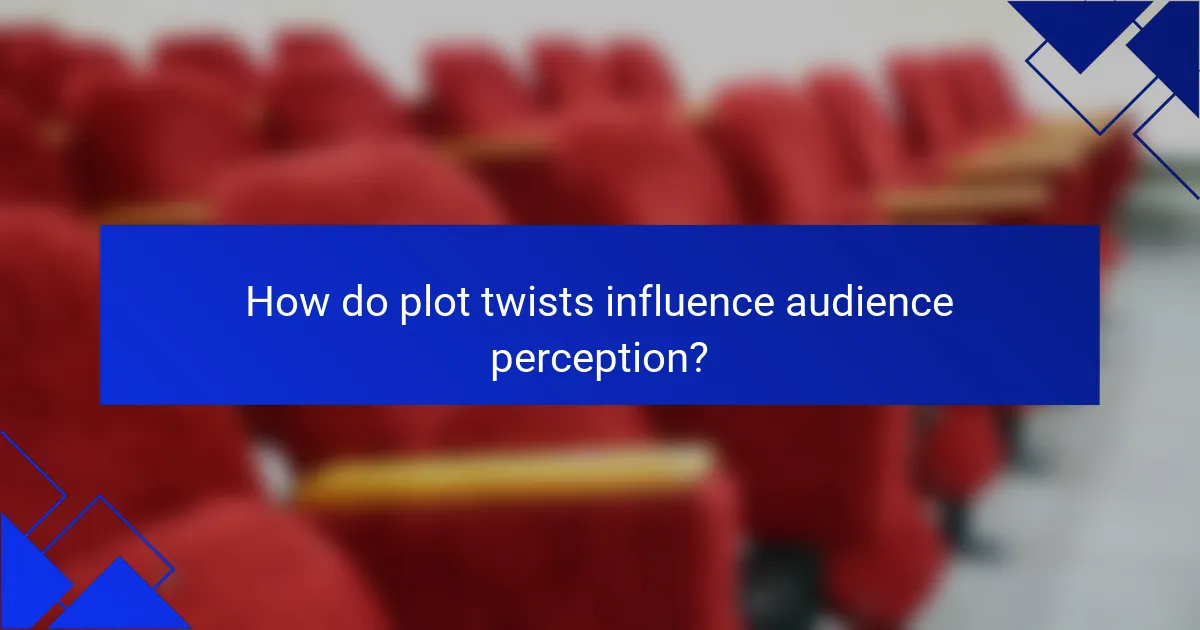
What are the key elements of mystery films?
Key elements of mystery films include a compelling plot, intriguing characters, and suspenseful atmosphere. The plot typically revolves around a crime or puzzle that needs solving. Characters often include a detective, suspects, and a victim. Suspense is built through red herrings and clues that mislead the audience. Tension escalates as the detective uncovers hidden truths. The resolution usually features a surprising twist that reveals the culprit. These elements engage viewers and provoke critical thinking. Mystery films often challenge audiences to solve the mystery alongside the characters.
How do plot twists enhance the storytelling in mystery films?
Plot twists enhance storytelling in mystery films by increasing suspense and engagement. They challenge audience expectations and provoke emotional responses. A well-executed plot twist can reveal hidden motives or connections, deepening the narrative complexity. This element maintains viewer interest by keeping them guessing. According to a study published in the Journal of Media Psychology, plot twists significantly improve viewer retention and satisfaction. They also encourage discussions and theories among audiences, enriching the overall experience.
What are some of the most memorable plot twists in cinematic history?
Some of the most memorable plot twists in cinematic history include “The Sixth Sense,” “Fight Club,” and “The Usual Suspects.” In “The Sixth Sense,” the twist reveals that Dr. Malcolm Crowe, played by Bruce Willis, is dead. This shocking revelation recontextualizes the entire narrative and enhances the film’s emotional impact. “Fight Club” features a twist where the protagonist discovers he has been imagining his alter ego, Tyler Durden, all along. This twist challenges viewers’ perceptions of identity and reality. In “The Usual Suspects,” the twist reveals that the seemingly weak character Verbal Kint is actually the criminal mastermind Keyser Söze. This unexpected turn leaves audiences reevaluating the clues presented throughout the film. These twists are significant because they redefine the story and engage viewers in a deeper way.
How do plot twists affect audience expectations?
Plot twists significantly alter audience expectations by subverting predicted outcomes. They create surprise and intrigue, leading viewers to reassess earlier assumptions. This shift in perspective heightens engagement and emotional investment. Research indicates that unexpected plot developments enhance memorability and enjoyment of narratives. A study by Green and Brock (2000) found that surprising twists can increase narrative transportation, making audiences more immersed in the story. Consequently, plot twists play a crucial role in shaping audience reactions and overall satisfaction with the film.
Who are the iconic detectives in mystery films?
Iconic detectives in mystery films include Sherlock Holmes, Hercule Poirot, and Sam Spade. Sherlock Holmes, created by Arthur Conan Doyle, is known for his sharp intellect and keen observation skills. He has been portrayed in numerous adaptations, including films starring Basil Rathbone and Robert Downey Jr. Hercule Poirot, created by Agatha Christie, is famous for his meticulous attention to detail and psychological insights. He appears in films like “Murder on the Orient Express,” played by actors such as Albert Finney and Kenneth Branagh. Sam Spade, from Dashiell Hammett’s “The Maltese Falcon,” is characterized by his tough demeanor and moral ambiguity. He was famously portrayed by Humphrey Bogart in the classic 1941 film. These characters have become cultural icons, influencing the detective genre in cinema.
What traits define a successful detective character?
A successful detective character is defined by traits such as keen observation, analytical thinking, and strong intuition. Keen observation allows the detective to notice details others might overlook. Analytical thinking enables them to piece together clues logically. Strong intuition helps in making connections that are not immediately obvious. Additionally, resilience is crucial for overcoming obstacles during investigations. Excellent communication skills facilitate interactions with witnesses and suspects. A moral compass drives the detective’s pursuit of justice. Empathy aids in understanding victims’ perspectives. Lastly, adaptability allows the detective to adjust strategies as new information emerges. These traits collectively contribute to the effectiveness and relatability of detective characters in mystery narratives.
How have iconic detectives evolved over time?
Iconic detectives have evolved significantly over time, reflecting changes in society and storytelling. Early detectives, like Sherlock Holmes, emphasized intellect and observation. They often solved crimes through deductive reasoning and scientific methods. In the mid-20th century, detectives like Philip Marlowe introduced a more cynical and flawed hero. This shift mirrored societal disillusionment post-World War II.
Contemporary detectives often grapple with personal demons and complex moral dilemmas. Characters like Lisbeth Salander showcase strong, unconventional traits. The evolution also includes diverse backgrounds and genders, appealing to a broader audience. This shift highlights changing societal norms and the demand for representation in media.
Overall, iconic detectives have transitioned from archetypal figures to multifaceted characters, adapting to cultural changes and audience expectations.
Why is audience engagement crucial in mystery films?
Audience engagement is crucial in mystery films because it enhances the viewer’s experience and investment in the story. Engaged audiences are more likely to pay attention to details and clues presented throughout the film. This active participation heightens suspense and intrigue, essential elements in the mystery genre. Research shows that films with high audience engagement have better retention of plot points and character motivations. For instance, a study by the University of Southern California found that viewers who actively discussed a mystery film afterward had a deeper understanding of its complexities. This interaction fosters a communal experience, encouraging viewers to share theories and interpretations. Ultimately, audience engagement transforms passive viewing into an interactive journey, making the resolution of the mystery more satisfying.
What techniques do filmmakers use to engage the audience?
Filmmakers use various techniques to engage the audience effectively. One technique is suspense, which keeps viewers on the edge of their seats. This is often achieved through pacing and the strategic placement of plot twists. Another technique is character development, allowing audiences to form emotional connections with the characters. Strong visual storytelling also plays a crucial role in engagement. Cinematography can evoke emotions and enhance the narrative. Additionally, sound design and music heighten tension and mood, influencing audience reactions. Filmmakers may also utilize cliffhangers to maintain interest and encourage viewers to return. These techniques are foundational in creating an immersive viewing experience.
How does audience engagement impact the success of a mystery film?
Audience engagement significantly impacts the success of a mystery film. Engaged audiences are more likely to connect with the plot and characters. This connection can lead to positive word-of-mouth promotion. According to a study by the University of Southern California, audience participation enhances emotional investment. Higher emotional investment often translates to increased box office revenue. Engaged viewers are also more likely to discuss the film on social media. This discussion can generate buzz and attract new viewers. Ultimately, strong audience engagement fosters a loyal fan base, ensuring the film’s longevity and success.

How do plot twists influence audience perception?
Plot twists significantly influence audience perception by altering their understanding of the narrative. They create surprise and challenge expectations. This shift can lead to heightened emotional responses. Research indicates that unexpected plot developments enhance engagement and retention. A study by Green and Brock (2000) found that surprising events improve narrative transportation. This transportation increases empathy towards characters. Consequently, plot twists can reshape the audience’s overall experience and interpretation of the story.
What psychological effects do plot twists have on viewers?
Plot twists create significant psychological effects on viewers. They often induce surprise, leading to heightened emotional responses. This surprise can trigger dopamine release, enhancing engagement with the narrative. Viewers may experience confusion, prompting them to reevaluate prior assumptions. This cognitive dissonance can lead to deeper analysis of the plot. Moreover, plot twists can create a sense of satisfaction or frustration, depending on their execution. Research indicates that well-crafted twists can increase viewer retention and discussion. A study by Green and Brock (2000) found that unexpected narrative turns can enhance emotional involvement and memory recall.
How do viewers react to unexpected plot developments?
Viewers often experience surprise and heightened emotional engagement in response to unexpected plot developments. This reaction can lead to increased interest in the narrative. Research indicates that plot twists can enhance viewer satisfaction and retention. A study by Green and Brock (2000) found that unexpected events in stories can create a stronger connection to characters. Additionally, viewers may discuss these plot twists with others, enhancing communal engagement. Such reactions are common in mystery films, where suspense and surprise are integral to the experience.
What role does foreshadowing play in plot twists?
Foreshadowing plays a crucial role in enhancing plot twists. It subtly hints at future events without revealing them outright. This technique builds anticipation and engages the audience. Effective foreshadowing creates an emotional connection to the plot. It allows viewers to feel a sense of satisfaction when the twist occurs. For example, in films like “The Sixth Sense,” early clues become significant during the twist. These hints make the twist more impactful and believable. Ultimately, foreshadowing enriches the storytelling experience by rewarding attentive viewers.
How do iconic detectives contribute to plot twists?
Iconic detectives contribute to plot twists by embodying traits that mislead the audience. They often possess keen observation skills that reveal crucial details. These details are strategically withheld until the climax. The detectives’ complex personalities can create unexpected alliances or betrayals. Their methods may defy conventional logic, leading to surprising conclusions. For example, Sherlock Holmes often uses deductive reasoning that appears obscure until the final reveal. This creates a dynamic tension between expectation and reality. The unpredictability of their actions enhances the plot’s complexity. Overall, iconic detectives serve as catalysts for twists that challenge audience assumptions.
What are some examples of detectives who have delivered surprising revelations?
Sherlock Holmes is a detective known for delivering surprising revelations. In “The Hound of the Baskervilles,” he uncovers the truth behind a legendary curse. His logical deductions reveal the real culprit behind the mysterious deaths. Hercule Poirot, another iconic detective, surprises audiences in “Murder on the Orient Express.” He reveals that all passengers contributed to the murder of Samuel Ratchett. Philip Marlowe, from Raymond Chandler’s novels, often uncovers shocking truths. In “The Big Sleep,” he discovers the dark secrets of the wealthy Sternwood family. These detectives exemplify the genre’s hallmark of unexpected twists and resolutions.
How do detective archetypes shape audience expectations for plot twists?
Detective archetypes significantly shape audience expectations for plot twists. These archetypes create familiar patterns in storytelling. Audiences anticipate how detectives will uncover truths based on established traits. For example, the “hard-boiled detective” often reveals twists through grit and intuition. In contrast, the “intellectual detective” relies on logic and deduction.
The predictability of these archetypes sets a framework for the plot. Audiences expect certain behaviors and decision-making processes from the detectives. This expectation can heighten the impact of unexpected twists. When a detective acts contrary to their archetype, it surprises viewers.
Research shows that audiences are more engaged when plot twists align with their expectations. A study by the University of Southern California found that familiarity with archetypes enhances viewer satisfaction. This connection between archetypes and audience anticipation drives the effectiveness of plot twists in mystery films.

What are the best practices for crafting engaging mystery films?
Engaging mystery films should feature a compelling plot with unexpected twists. A strong narrative keeps audiences guessing. Establishing well-developed characters adds depth to the story. The protagonist must be relatable yet flawed to create tension. Incorporating red herrings misleads viewers effectively. A well-paced reveal of clues maintains suspense throughout the film. Utilizing atmospheric settings enhances the overall mood. Finally, an impactful resolution ties up loose ends while leaving some questions unanswered.
How can filmmakers effectively build suspense in their stories?
Filmmakers can effectively build suspense by creating uncertainty and tension throughout their stories. They often use techniques such as pacing, foreshadowing, and sound design. Pacing involves controlling the timing of events to heighten anticipation. Foreshadowing hints at future events, keeping the audience guessing. Sound design, including music and sound effects, enhances emotional responses and builds tension.
For example, Alfred Hitchcock mastered these techniques in films like “Psycho,” where the use of music intensified suspenseful moments. Research indicates that suspense is heightened when audiences are aware of potential threats but do not know when they will occur. This principle is supported by “The Psychology of Suspense” study, which explores viewer engagement and emotional responses.
What narrative techniques enhance tension and mystery?
Narrative techniques that enhance tension and mystery include foreshadowing, unreliable narrators, and cliffhangers. Foreshadowing subtly hints at future events, creating anticipation. This technique keeps the audience engaged and guessing. Unreliable narrators provide distorted perspectives, leading to uncertainty about the truth. This creates an atmosphere of doubt and intrigue. Cliffhangers leave unresolved situations at the end of scenes or chapters. They compel the audience to keep watching or reading for resolution. These techniques are widely used in mystery films to maintain suspense and keep viewers invested in the narrative.
How do pacing and timing influence audience engagement?
Pacing and timing significantly influence audience engagement by controlling the rhythm and flow of a narrative. Effective pacing maintains viewer interest by alternating between tension and release. For instance, a slower pace allows for character development and emotional connection. Conversely, a faster pace can heighten suspense and excitement. Research shows that films with well-timed plot twists keep audiences more engaged. According to a study by the University of Southern California, films with optimal pacing score higher in audience retention and satisfaction. Thus, pacing and timing are crucial for maximizing audience engagement in mystery films.
What tips can writers follow to create memorable plot twists?
Writers can create memorable plot twists by planting subtle clues throughout the narrative. These clues should be carefully woven into the story, allowing readers to revisit them after the twist is revealed. Foreshadowing is essential; it prepares the audience for the twist without making it obvious. Writers should also develop complex characters with hidden motives. This complexity can lead to unexpected revelations that surprise the audience.
Pacing is crucial when building up to a twist. A well-timed reveal can enhance the impact of the twist. Writers should consider using misdirection to lead readers to false conclusions. This technique can create a more shocking and satisfying twist when the truth is uncovered. Additionally, maintaining suspense throughout the story keeps readers engaged and invested in the outcome.
Finally, testing the twist on beta readers can provide valuable feedback. Their reactions can help writers refine the twist for maximum effect. Overall, these strategies can significantly enhance the memorability of plot twists in writing.
How can writers balance predictability and surprise in their narratives?
Writers can balance predictability and surprise by strategically crafting their narratives. They should establish a clear set of expectations early in the story. This allows readers to form predictions about the plot. Introducing unexpected elements can then disrupt these predictions. For instance, a character’s hidden motive can serve as a surprise twist. Writers can also use foreshadowing to hint at surprises without making them obvious. This technique maintains suspense while keeping readers engaged. Additionally, varying the pacing of revelations helps to control predictability. Research indicates that effective plot twists enhance audience satisfaction in mystery narratives.
What common pitfalls should be avoided when writing plot twists?
Common pitfalls to avoid when writing plot twists include making them too predictable. Predictability can frustrate the audience and reduce engagement. Another pitfall is using twists that lack proper foreshadowing. Effective foreshadowing builds anticipation and makes the twist feel earned. Additionally, avoid twists that contradict established character behavior. Characters should act consistently to maintain credibility. Overcomplicating the twist can also alienate viewers. A convoluted twist may confuse rather than surprise. Lastly, avoid introducing new characters or elements solely for the twist. This can feel like a cheat and undermine the story’s integrity.
What resources are available for aspiring mystery filmmakers?
Aspiring mystery filmmakers can access various resources to enhance their skills and knowledge. Online platforms like MasterClass offer courses from established filmmakers. Books such as “The Anatomy of Story” by John Truby provide insights into storytelling techniques. Film festivals like the Sundance Film Festival showcase mystery films and offer networking opportunities. Additionally, organizations like the International Mystery Writers Association provide resources and support for writers and filmmakers. Websites like No Film School offer articles and tutorials on filmmaking techniques. Finally, local community colleges often have filmmaking programs that include courses focused on genre-specific storytelling.
The main entity of the article is mystery films, focusing on their key elements, including plot twists, iconic detectives, and audience engagement. The article analyzes how compelling plots, intriguing characters, and suspenseful atmospheres are essential in mystery films, while exploring the impact of plot twists on storytelling and audience expectations. It discusses iconic detectives like Sherlock Holmes and Hercule Poirot, detailing their traits and evolution over time. Additionally, the article emphasizes the importance of audience engagement and techniques filmmakers use to enhance viewer experience, ultimately providing insights into best practices for crafting effective mystery narratives.